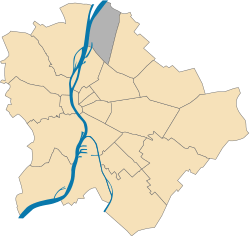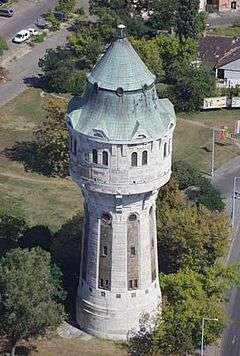Újpest
Újpest (Hungarian pronunciation: [ˈuːjpɛʃt]; German: Neu-Pest, English: New Pest)[3][4] is the 4th District in Budapest, Hungary. It is located on the left bank of the Danube River. The name Újpest means "new Pest" because the city was formed on the border of the city of Pest, Hungary in 1838.[4] Újpest was a village for 6 decades until 1907 when it became a town. In 1950, the town was unified with Budapest to form Greater Budapest. Since 1950, Újpest is the 4th District of Budapest.
4th District of Budapest Budapest IV. kerülete Újpest | |
|---|---|
| District IV | |
 Flag  Coat of arms | |
 Location of District IV in Budapest (shown in grey) | |
| Coordinates: 47°34′N 19°05′E | |
| Country | Hungary |
| Region | Central Hungary |
| City | Budapest |
| Established | 1 January 1950 |
| Quarters[1] | List
|
| Government | |
| • Mayor | Tibor Déri (Momentum Movement) |
| Area | |
| • Total | 18.82 km2 (7.27 sq mi) |
| Area rank | 8th |
| Population (2018)[2] | |
| • Total | 100,694 |
| • Rank | 6th |
| • Density | 5,396/km2 (13,980/sq mi) |
| Demonym(s) | negyedik kerületi ("4th districter") |
| Time zone | UTC+1 (CET) |
| • Summer (DST) | UTC+2 (CEST) |
| Postal code | 1041 ... 1048 |
| Website | www |
The football club Újpest FC is named after the area, since they were formed in the district in 1885, and have played there since.
District
The district is composed of six parts. Újpest is the largest, but the district also includes Megyer, Káposztásmegyer, Istvántelek, Székesdűlő and the northern tip of the island Népsziget.[5]
History
Isaac Lowy owned a shoe factory that he wanted to move to Pest but was unable to attain a settlement permit because he was Jewish.[3] In 1835, he decided to create a new town where he would build the factory.[3] North of Pest, there was an empty tract of land that was owned by the Károlyi nobles.[3] Lowy bought the land; the deed included the right of religious freedom, the right to self-government, and the right to engage in business.[3] By 1838, 13 Jewish families lived in Újpest; soon thereafter Christians began moving in.[4]
Famous statues, like Wesselényi Monument, Matthias Corvinus Monument, were cast in bronze by the workshops of Alexander Matthias Beschorner from Újpest.
Sport
- Újpest FC, football team
- Újpesti Törekvés SE, football team
- Újpesti MTE, football team
- Újpesti TE (men's water polo)
- Újpesti TE (ice hockey)
- Újpest Bulldogs, American football team
Politics
The current mayor of IV. District of Budapest is Tibor Déri (Momentum).
The District Assembly, elected at the 2019 local government elections, is made up of 21 members (1 Mayor, 14 Individual constituencies MEPs and 6 Compensation List MEPs) divided into this political parties and alliances:[6]
| Party | Seats | Current District Assembly | |||||||||||||||
|---|---|---|---|---|---|---|---|---|---|---|---|---|---|---|---|---|---|
| Opposition coalition[lower-alpha 1] | 15 | M | |||||||||||||||
| WZs-ÚE-Fidesz | 6 | ||||||||||||||||
List of mayors
| Member | Party | Date | |
|---|---|---|---|
| Tamás Derce | SZDSZ | 1990–2010 | |
| Ind. | |||
| Zsolt Wintermantel | Fidesz | 2010–2019 | |
| Tibor Déri | Momentum | 2019– | |
Famous residents
- Julius Dessauer (b. 1832), rabbi and writer.[7]
- Lipa Goldman (b. 1905) chief rabbi of the Orthodox Jewish Community.[8]
- Yosef Goldman scholar and bookdealer.[9]
- Olivér Halassy (1909–1946), water polo player and freestyle swimmer.[10]
- Isaac Lowy (1793–1847), Hungarian industrialist and founder of Újpest.[3][4]
- Alexander Rado (1899–1981), Soviet spy.[11]
- Ferenc Szusza[12]
- Ludwig Venetianer (1867–1922), rabbi and writer.[13]
Twin towns
Újpest is twinned with:
Image gallery
 Megyeri bridge
Megyeri bridge Ramada Resort Aquaworld
Ramada Resort Aquaworld Ute stadium
Ute stadium Town Hall
Town Hall- Town Hall
 Water tower
Water tower Parish Church
Parish Church- Parish Church
See also
| Wikimedia Commons has media related to Budapest District IV. |
- List of districts in Budapest
- Ujpest Synagogue
References
- "94/2012. (XII. 27.) Főv. Kgy. rendelet - a közterület- és városrésznevek megállapításáról, azok jelöléséről, valamint a házszám-megállapítás szabályairól" (in Hungarian).
- "A fővárosi kerületek, a megyei jogú városok, a városok területe, lakónépessége és a lakások száma" [The area of districts of the capital, of the towns with county's rights, resident population and number of dwellings]. Magyarország közigazgatási helynévkönyve 2016. január 1 [Gazetteer of Hungary 1st January, 2016] (PDF). Hungarian Central Statistical Office. 2016. p. 21.
- Patai, Raphael (1996). The Jews of Hungary. 265: Wayne State University Press. p. 730. ISBN 978-0-8143-2561-2.CS1 maint: location (link)
- Valley, Eli (1999). The Great Jewish Cities of Central and Eastern Europe: A Travel Guide and Resource Book to Prague, Warsaw, Crakow, and Budapest. Jason Aronson. p. 538. ISBN 0-7657-6000-2.
- Tamás S Kiss. "Workers' town revisited". Budapest Sun. Archived from the original on 28 July 2009. Retrieved 3 January 2008.
- "Városi közgyűlés tagjai 2019-2024 - Budapest IV. kerület". valasztas.hu. Retrieved 1 November 2019.
- "Julies Dessauer". Jewish Encyclopedia. Retrieved 3 January 2008.
- Jack Roth (6 April 1949). "DP Rabbi, Family Dock, Full of Joy". The New York Times. Retrieved 11 March 2008.
- Yitzchak Levine (6 December 2006). "Hooked On American Jewish History". Jewish Press. Retrieved 3 January 2008.
- profile Archived 2007-09-27 at the Wayback Machine (in Hungarian). Retrieved on 2008-01-03.
- Alexander Rado, Central Intelligence Agency. Retrieved on 2008-01-03
- Ferenc Szusza, imdb.com. Retrieved on 2008-01-03.
- Isidore Singer. "Ludwig Venetianer". Jewish Encyclopedia. Retrieved 3 January 2008.
